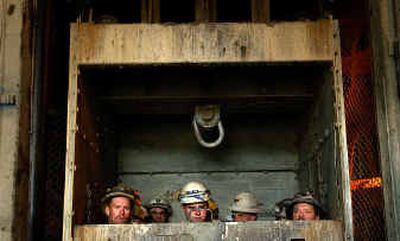Future brighter at Lucky Friday

MULLAN, Idaho – Rick Norman works at a hot and dirty job, but neither 90-degree temperatures nor rampant humidity could quash the Lucky Friday miner’s jovial mood Monday afternoon.
Each borehole from his roaring jumbo drill brought Norman and his co-workers closer to their goal: a deposit containing 28 million ounces of silver.
The silver is located nearly 6,000 feet below sea level in the foothills of eastern Shoshone County. Miners will drill through more than a mile of jagged, gray quartzite rock to reach the vein. They’re about one-third of the way to their destination, which they should reach by the end of the year.
The deposit considerably brightens prospects for the Lucky Friday, a historic silver mine that appeared headed for closure three years ago. With workings more than a mile underground, the mine is one of the deepest hardrock mines in the United States, which makes it one of the costliest to operate. By late 2001, the Lucky Friday’s future looked grim.
The mine was losing nearly $1 on each ounce of silver mined. To stem the loss, Hecla Mining Co. laid off more than 100 workers, and the board delayed spending the $8.5 million needed to tunnel to the 28 million ounces of silver.
“That was about as low as we got here. Silver prices were low, lead prices were low. It was not a good climate for investing in the mine,” said Mike Dexter, mine manager.
But the Lucky Friday’s fortunes are again on the upswing, thanks to a combination of factors.
The 60 workers who stayed “did a hell of a job,” Dexter said. Rising worker production helped convince Hecla’s board to approve the $8.5 million mine expansion in December. Silver prices rose as well, from below $5 per ounce to current prices near $6.
Now, mine officials predict that the Lucky Friday will operate through at least 2011 and probably longer. The mine’s silver production will double to about 4 million ounces annually after the new area goes into production in late 2005. And the Lucky Friday should turn a profit, too, if the mine meets its goal of producing silver for $4.50 per ounce.
The turnaround is gratifying in the Silver Valley, where the Lucky Friday has been an employer for more than 45 years, local officials said. Mining provides some of the highest wages in the region – an average of $43,600 annually, compared to Shoshone County’s average annual wage of $24,300.
“They provide us stability while our local economy is trying to diversify,” said Vince Rinaldi, executive director of the Silver Valley Economic Development Corp. “I get excited about the potential for the people who left the area to come back.”
Norman spent a year working at the Stillwater platinum mine in Nye, Mont., after the Lucky Friday layoffs.
“It means everything for the family for this place to continue,” said Norman, who worked seven days on, seven days off shifts, returning to Wallace to see his family on his days off. But he said he missed too many of his son’s football and basketball games.
“It’s hard to raise a 15-year-old kid,” he said. “If his grades weren’t good, I wasn’t there to direct him.”
Roy Philp spent nine months at a mine in Elko, Nev., after the layoffs. But he, too, wanted to be closer to his three teenagers, who were living with his ex-wife in Wallace.
“I made sure my name was on the recall list,” said Philp, a “nipper,” or miner’s assistant, who has worked at the Lucky Friday for six years.
The mine now employs 132 people, with plans to hire eight more, though it won’t reach its pre-layoff level of 200, Dexter said.
The Lucky Friday is one of two operating mines that remain in Silver Valley, which was once home to 4,000 miners and smelter workers. Though the hey-day of mining is past, “There’s a culture here that cannot easily be replaced,” said Vicki Veltkamp, Hecla’s vice president of investor and public affairs.
At the Lucky Friday, the average age of miners is 52. They’re known for their expertise in underground mining, and Hecla sends them to its mines in Latin America to train young workers, she said.
The mine also contains the company’s largest silver reserves, Veltkamp said. Hecla engineers believe the Lucky Friday, which has produced over 127 million ounces of silver over nearly five decades, could still contain 90 million more ounces of silver.
“This is where we have the most silver for the long-term,” she said. “When the price of silver goes up, we get the most benefit, and the most leverage.”